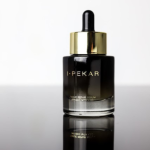No products in the cart.
Menu
What is the Menstrual Cycle?
The menstrual cycle is a natural biological process that prepares a woman's body for pregnancy. If pregnancy does not occur, the lining of the uterus sheds, resulting in a period. This cycle typically lasts 28 days, though it can range from 21 to 35 days. Young women usually experience their first period around age 12.
Your mood and cravings aren’t the only things affected by your menstrual cycle—your skin goes through changes too. Many women experience oilier skin and breakouts, with studies showing that nearly half of women deal with premenstrual acne flares.
These skin changes are triggered by hormonal fluctuations. For example, shifts in estrogen levels can impact your skin’s texture, moisture balance, and thickness. Additionally, hormonal changes can boost sebum production, which can mix with dead skin cells, clog pores, and lead to acne.
Phases of the Menstrual Cycle
The menstrual cycle consists of four main phases, each with unique hormonal changes that impact the skin:
Menstruation Phase (Days 1 - 5)
During menstruation, estrogen and progesterone levels are at their lowest, weakening the skin barrier and increasing dryness and sensitivity. This makes the skin more vulnerable to irritation and environmental damage.
💡 Skin care Tips 💡
Follicular Phase (Days 7 to 11)
This phase starts on the first day of your period and continues until ovulation. During this time, estrogen levels rise, boosting the production of collagen, elastin, and hyaluronic acid. This encourages the development of more elastic skin cells and increases cell turnover, resulting in a plumper, fresher, and more youthful complexion.
💡 Skin care tips 💡

Ovulation Phase (Days 12 to 16)
Leading up to ovulation, rising estrogen levels give your skin a radiant, glowing appearance. The increase in estrogen triggers the pituitary gland to release luteinizing hormone, prompting the ovary to release an egg. If the egg isn't fertilized during this phase, it will eventually disintegrate.
💡 Skin care tips 💡

Luteal Phase (Days 17 to 28)
During this phase, progesterone levels rise to prepare the uterine lining for potential pregnancy. This increase in progesterone can stimulate your sebaceous glands to produce more oil, often leading to acne breakouts right before your period.
💡 Skin care tips 💡
It is also worth noting that not all types of acne are related to your hormones or menstrual cycle. Acne affects both males and females, as well as teens and adults. There are also a few other factors that may trigger or worsen acne, including diet, genetics, certain medications, and stress.
💡 Here are a few things that can help 💡
By tailoring skincare to the menstrual cycle, you can better support your skin’s health and resilience.
I hope this helps anyone struggling with acne! If you have any questions or suggestions for future blog topics, please let me know. Each month, I try to write about issues that many of you are asking about or facing.
XOXO, Ildi
Happy New Year! As we step into 2025, it’s the perfect time to reflect, set new goals, and focus on what truly matters—ourselves. Every year, I write about two main topics, but this time, I want to expand and dive deeper into something I believe is incredibly important: self-care. Too often, we push ourselves to […]
As December blankets New York City in its frosty embrace, it marks more than just the end of a year—it’s an invitation to slow down, reflect, and at Ildi Pekar studio we believe true beauty and wellness come from a harmonious relationship between your body, mind, and spirit. This month, let’s explore how we can […]
The weight loss drug Ozempic has gained a lot of attention for its ability to help people shed pounds quickly. However, there’s a growing concern about one of its side effects, commonly referred to as “Ozempic face.” This term describes the premature aging some users experience, with skin sagging, hollow cheeks, and a more gaunt […]